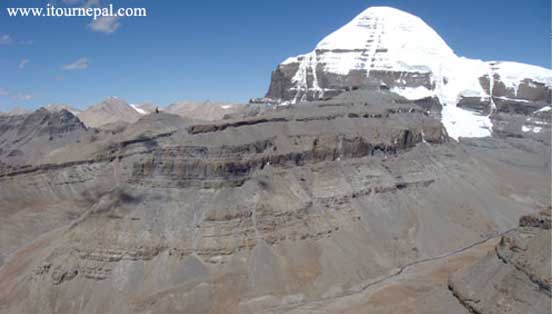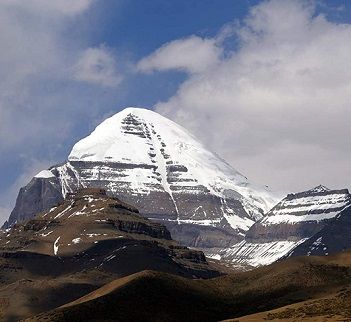Mt. Kailash
Mt. Kailash raises 6714 m (22156 ft) above sea level. For four major religions of Asia, i.e. Buddhism, Jainism, Bonpo (pre-Buddhist religion) and Hinduism, Mount Kailash is the sacred. For the Buddhists, Kailash is the center point of the universe. For the Jains, Kailash is the Mount Ashtapada, a very holy place of pilgrimage. For the Bonpo followers, Kailash is the nine-faced swastika mountain and is constantly emanating great power. For the Hindus Kailash is the Sumeru Parvat, the throne of Lord Shiva and the spiritual center of the world around which all the earthly powers revolve.
For explorers it is one of the most remote place, yet to be discovered in the world with average altitude over 4,500 masl.
Kailash Yatra (Journey)
There are several ways of getting there. India and China government organize pilgrimage via Indian route each year. Many people get to Lhasa and then organize tour to western Tibet. But the route from Nepal is shorter and most preferred by Indian pilgrims.
Normally it is a program of about 14 nights and 15 days including 3 nights in Nepal. Making it shorter is possible but it is better to have plenty of time for acclimatization and to play with weather. So the first couple of nights are in Nepal exploring Kathamndu and preparing for the journey. There will be a meeting with experts regarding the Yatra, where they will brief everything. Kathmandu is a perfect place to do the last hour preparation before you enter Tibet.
The 3rd day we start early in the morning towards Kodari Border (105 km). We will arrive in Nyalam at 3,750 m of Tibet late in the afternoon even though it is just 150 km from Kathmandu. The region is the immigration formalities and time differences. This is a starting of our 1,000 km journey to Mt. Kailash. However, the road is tared road from 2011 and the vehicle is comfortable (Toyota Land cruiser) .
Day 4 is a rest day for acclimatization. It is necessary as we will climb further to over 5,000m in following days. At Nyalam we are in the middle of two different landscape in the corner of the Himalaya. Further from here we will enter the Tibetan Plateau. We go for a easy hike up the ridge marked by prayer flags and strolled in a Nyalam market. This is the place where few people started to show basic symptoms of Acute Mountain Symptoms. Broken sleep, nausea, fatigue and lost of appetite appeared in few.
Day 5 was the worst as we had to drive for about 6 hrs / 280 km to Saga at 4,500m. We first came up to the Nyalam Pass (5,100m) and then drove at the average altitude of 4,800 for about 3 hrs. People with symptoms got sick that day with headache and throwing. Facilities of doctor in the hotel made it more comfortable for the sick. They felt better the next day. From here onward for days 6 and 7, we will be at the same altitude. So people get to acclimatize more before we arrive to the base of Mt. Kailash.
Day 7 is longest but very exciting as we get the first glimpse of Mt. Kailash and Manasarover. Everyone forgets the tedious journey. At around noon we arrive to Manasarover and sit down in Tsherchakang for prayers. Tears of happiness burst in our eyes as the dream of physically seeing Mt, Kailash comes true. Our Manasarover cora starts on the same day. There are several points where the water is crystal clear on the pebbles. We can touch the water and fetch it to bring back. Tshugompa is a place where we normally camp for that night. Mud houses are available as accommodation.
On the day 8 we drive 40 km to Tarchen (4,700m) after morning homum puja on the bank of Manasarover. If the weather is clear, we will drive 20 mints to Austapad. Austapad is is the closest we can get to South Face of Kailash. If we have extra day, one can explore to the base of Mt. Kailash, Atma Lingam. This is from where pilgrims start their Nandi Cora.
Day 09 is the first day of our Kailash outer Parikrima. The total parikrima is about 52 km. We will drive part of it in the beginning and at the end. The first day of the Mt. Kailash Cora is easy with gradual climb at the end to Derapuk. We will drive to Tarpuch, valley of god and start walking. Many pilgrims pre-arrange horse. The walking is about 12 km and we see the western face of Mt. Kailash on the way. Derapuk at the altitude of 5,000m is perfectly located to view golden North Face.
Day 10 is bit tough as the day was long and we had a climbing to Dolmala (5,750m) ahead. The climbing starts after crossing the river. Almost 8,00 m of steep climb with snow at the top most of the time is really challenging, especially for pilgrims. We are backed up by the feeling that once you are at the pass, it's like our journey back to home started. The pass is swathe with prayer flags. Just about 100 m below the pass is Gauri Kunda. Since it is steep rockery from the trail, people send their helpers to fetch Jalam (holy water) from the lake. The trail further winds through rockery and snow fields to the top of steep downhill with scree. After about couple of hrs from the top, we arrive to the valley basin. There will be few nomad tents selling some drinks, hot water, noodles and snacks. This is where we eat our pack lunch. The walk further is along the valley for about 4 hrs to Zutulpuk. Zutulpuk has got a beautiful monastery with meditation cave of Milarepa.
Day 11 is easy and we can see cheerful faces of the people as they accomplish the Holy Parikrima. It is about 2 and half hrs walking till the road where our cars will be waiting. From there we collected our luggage and drove to Manasarover for night halt. This is the day when we celebrate our successful journey and enjoy the view of Kailash and Manasarover.
Rest of the days will be driving back to the border and to Nepal.







 Reply With Quote
Reply With Quote
Bookmarks